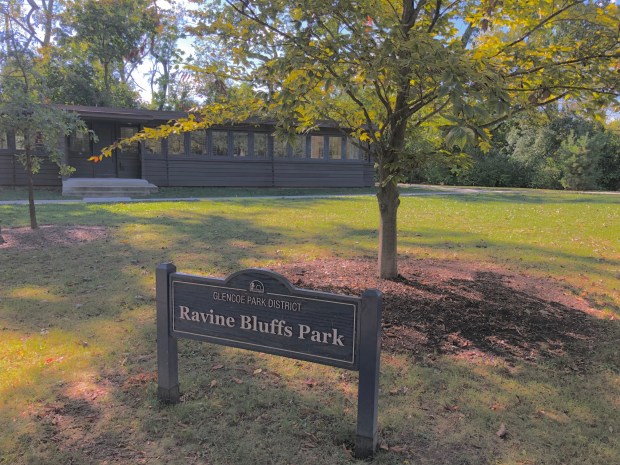The Glencoe Historical Society has removed the name of Sherman Booth from a Frank Lloyd Wright-designed cottage after discovering the wide-ranging extent of Booth’s racist efforts to reduce the number of Black residents, as well as Italian and Greek residents, from Glencoe roughly 100 years ago by using racially restrictive real estate covenants.
The cottage, in Glencoe’s Ravine Bluffs neighborhood, was designed by the noted architect Wright as a gift to Booth, his friend and attorney. The historical society took possession of the structure in 2020 to protect it from demolition.
“The ultimate and intended impact of Booth’s action was to drive away Black and Italian residents and to effectively prevent them from returning,” the historical society’s board of directors said in a statement.
Historical Society officials said they were previously aware of the large decline in Glencoe’s Black population in the 1920s, but they were not aware of Booth’s role until the completion of research for the society’s ongoing “Blacks in Glencoe” exhibit.
“We cannot change our history, but we are committed to truthfully reporting it and learning from the mistakes of those who came before us,” the statement said.
The officials’ statement called Booth the “racist original owner” of the cottage, which the society has renamed the Ravine Bluffs Cottage.
Upon conducting research to discover why the numbers of Blacks living in Glencoe fell so sharply during the 1920s, the historical society concluded Booth oversaw a plan placing racially restrictive covenants on homes in southern Glencoe.
Blacks represented about 10% of the village’s population in 1920; 10 years later that number had been cut in half, according to the historical society.
Booth’s racist covenants also affected Italians and Greeks, who were not considered to be Caucasian in the early 1900s by many white American Protestants, the group that defined “Americanness” and generally held power at the time. In those decades, U.S. officials often described them as “brown,” or “swarthy,” on their immigration papers, according to Carla Simonini, former Rubino Endowed Professor of Italian American Studies at Loyola University of Chicago.
A 1911 Congressional report concluded that Italian immigrants, particularly those from Southern Italy, were a threat to American society due to what so-called experts at the time, long since debunked, called their genetic inferiority, lack of skills, high illiteracy rate and propensity to violence, she reported.
The Glencoe Historical Society traced Booth’s actions back to 1919 when he spearheaded the creation of the Glencoe Homes Association, also known as “The Syndicate.” This organization would purchase homes in southern Glencoe, where many Blacks lived at the time.
Historical society officials believe Booth oversaw a system where shares were sold of the Glencoe Homes Association for $1,000 each and then the Syndicate used those funds to buy properties owned by minorities via a secret land trust created and overseen by Booth.
Booth frequently notarized the property sales with the corresponding deeds, filled with restrictions on each property, via personal direction written on his law office letterhead, historical society officials concluded.
“The sales deeds contained severe restrictions on each property, including covenants prohibiting the sale, lease or occupancy, initially by “anyone who is not a Caucasian,” and later, more specifically, stating, “that said premises shall never be sold to, used or occupied by what are commonly known as Negroes, or Italians, or Greeks, or descendants thereof and that if this provision is violated … then the title thereto shall revert” to the Syndicate,” according to a historical society statement.
The historical society concluded “The Syndicate” subsequently purchased large sections of vacant land in southern Glencoe until sales began to slow. Then as a founding member of the Glencoe Park District, Booth led an effort to use that public body’s eminent domain condemnation powers to build parks on property that is now Green Bay Road, South School and later near Watts Park in southern Glencoe, as part of the plan to reduce minority population.
Soon many of the Blacks and the Italians who had previously refused to sell to the Syndicate left Glencoe as their houses were taken, even if they did receive market prices, per the historical society.
“The issue was not whether the park district had the power to take the land; the issue was what the fair market value (was) they had to be paid,” Historical Society Co-President Karen Ettelson said.
Ettelson noted there were 18 property owners who objected to the Park District’s plan, and the matter was eventually decided by the Cook County courts.
Historical society officials at first thought The Syndicate initially had made 130 purchases in southern Glencoe, but after the additional research, officials believe there were far more.
The U.S. Supreme Court ruled racially-restrictive covenants were unenforceable in 1948, but the impact of Booth’s action remained in Glencoe for many years afterward.
”As late as 1960, the mortgage lender of a Black purchaser still insisted on a release of the Syndicate’s reverter signed by Sherman M. Booth – even though Booth had died four years earlier,” the historical society concluded.
Today, Glencoe has a population of almost 8,850 people with just about 1% being Black, according to the U.S. Census bureau website.
After realizing the extent of Booth’s actions, the historical society board voted unanimously to strip his name off the cottage. Since the property is on Glencoe Park District land, the corresponding name change on the signage outside the cottage required park district board approval. Park commissioners voted unanimously to support the move at their September meeting.
Park Board President Carol Spain stated Booth’s role at the park board was unfortunate.
“It is certainly something we are not proud of and we acknowledge and we are committed to diversity and inclusion and condemn the practices he did at the time,” Spain said in an interview. “In no way do we want to prevent the community from understanding the history.”
The name removal of the one-story cottage marks another chapter in its recent history.
Wright originally designed it in 1913 to be a temporary residence for Booth and his wife, Elizabeth, a leading Illinois suffragist and their two children, Ettelson said.
In 2019, the cottage faced an uncertain future as the new owners of the land at 239 Franklin Road, where it was then located, appeared interested in razing the cottage to make space for new construction.
The destruction of a Wright-designed structure alarmed preservationists and eventually the cottage was donated to the historical society. They struck a deal with the park district to move it onto a section of vacant land about a quarter mile away at 301 Maple Hill Road.
In July 2020, the cottage was lifted up and moved to its new location.
The historical society is leasing the space from the park district for 99 years at the nominal rate of a dollar per year, Ettelson said.
The cottage may be the only structure in Glencoe with Booth’s name on it. Both Spain and Village Manager Phil Kiraly said they were not aware of anything else named for Booth either on park district or village-owned properties.




